GMC SIERRA 1994 Owners Manual
Manufacturer: GMC, Model Year: 1994, Model line: SIERRA, Model: GMC SIERRA 1994Pages: 404, PDF Size: 20.91 MB
Page 291 of 404
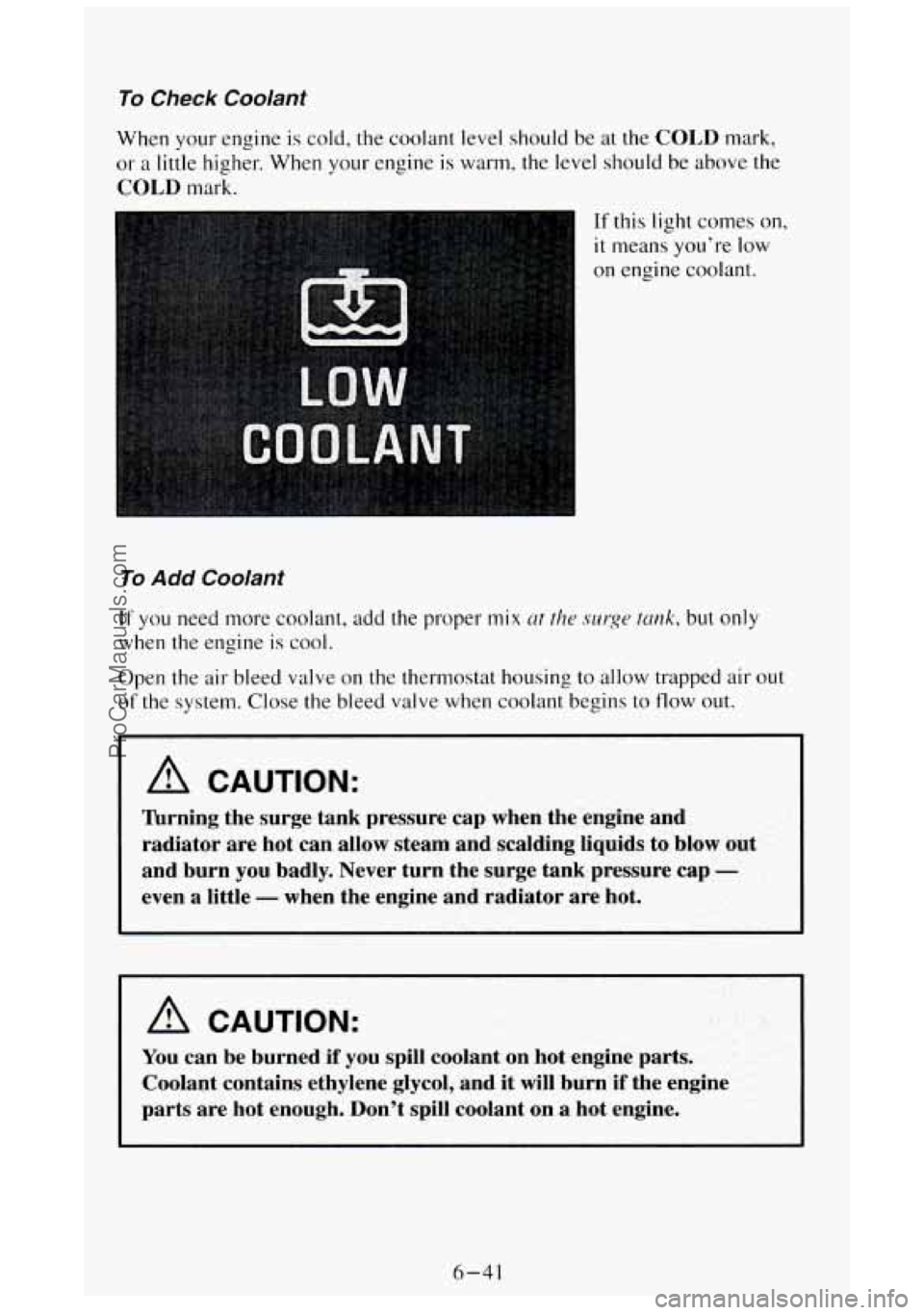
To Check Coolant
When your engine is cold, the coolant level should be at the COLD mark,
or a little higher. When your engine is warm, the level should be above the
COLD mark.
If this light comes on,
it means you’re low
on engine coolant.
To Add Coolant
If you need more coolant, add the proper mix at the surge tnnk, but only
when the engine is cool.
Open the air bleed valve on the thermostat housing to allow trapped air
out
of the system. Close the bleed valve when coolant begins to flow out.
I A CAUTION:
nrning the surge tank pressure cap when the engine and
radiator are hot can allow steam and scalding liquids to blow
out:
and burn you badly. Never turn the surge tank pressure cap -
even a little - when the engine and radiator are hot.
A CAUTION:
You can be burned if you spill coolant on hot engine parts.
Coolant contains ethylene glycol, and it will burn if the engine
parts are hot enough. Don’t spill coolant on
a hot engine.
6-41
ProCarManuals.com
Page 292 of 404

Radiator Pressure Cap-Gas Engines
The radiator pressure
cap must be tightly
installed with the
arrows
on the cap
lined
up with the
overflow tube
on the
radiator filler neck.
NOTICE:
Your radiator cap is a 15 psi (105 kPa) pressure-type cap and
must be tightly installed to prevent coolant
loss and possible
engine damage from overheating. Be sure the arrows
on the cap
line
up with the overflow tube on the radiator filler neck.
Surge Tank Pressure Cap- Diesel Engines
6-42
ProCarManuals.com
Page 293 of 404
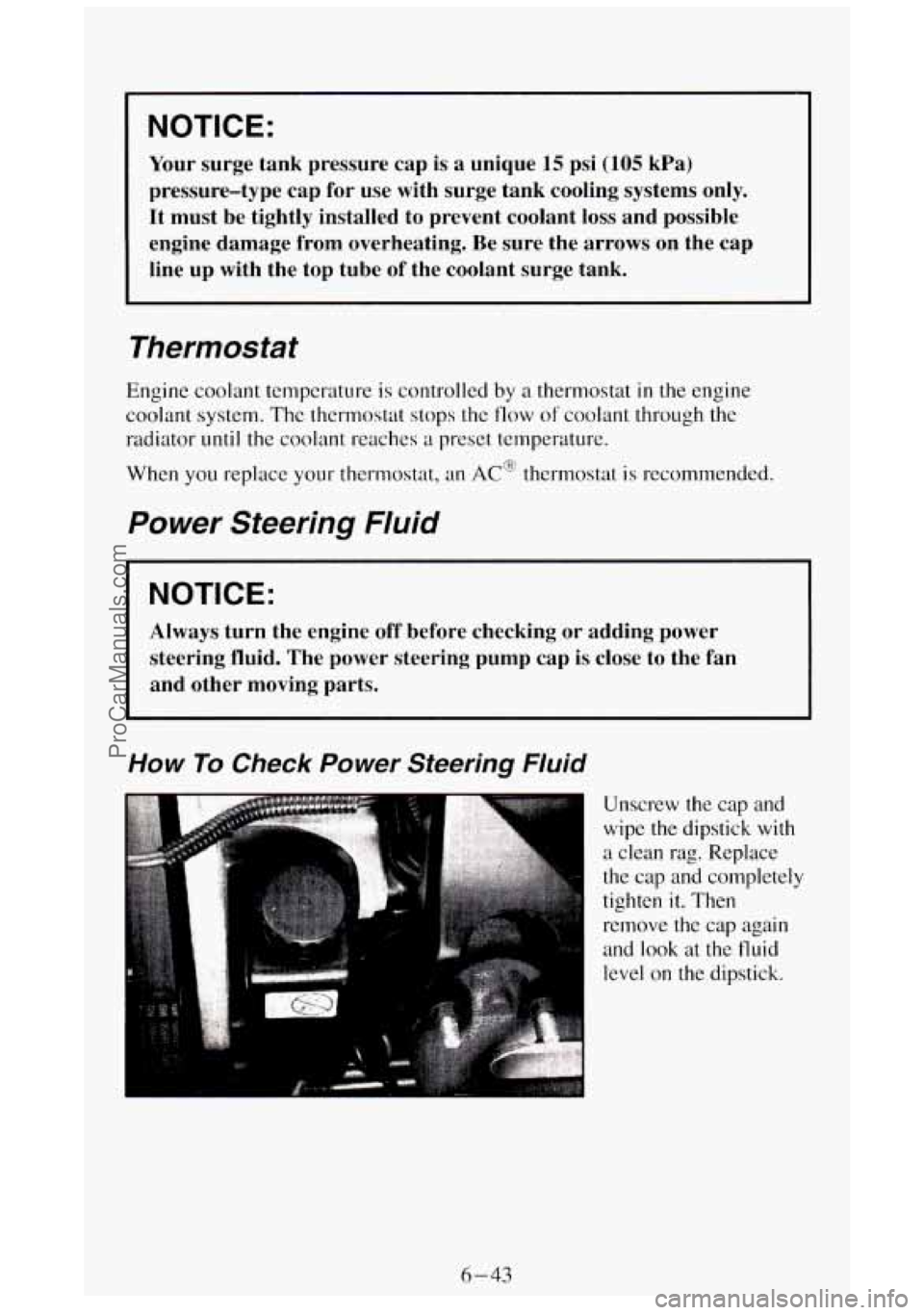
NOTICE:
Your surge tank pressure cap is a unique 15 psi (105 kPa)
pressure-type cap for use with surge tank cooling systems only.
It must be tightly installed to prevent coolant
loss and possible
engine damage from overheating. Be sure the arrows on the cap
line up with the top tube
of the coolant surge tank.
Thermostat
Engine coolant temperature is controlled by a thermostat in the engine
coolant system. The thermostat stops
the flow of coolant through the
radiator
until the coolant reaches a preset temperature.
When
you replace your thermostat, an AC" thermostat is recommended.
Power Steering Fluid
NOTICE:
Always turn the engine off before checking or adding power
steering fluid. The power steering pump cap is close to the fan
and other moving parts.
How To Check Power Steering Fluid
Unscrew the cap and
wipe the dipstick
with
a clean rag. Replace
the cap and completely
tighten it. Then
remove the cap again
and
look at the fluid
level on the dipstick.
6-43
ProCarManuals.com
Page 294 of 404
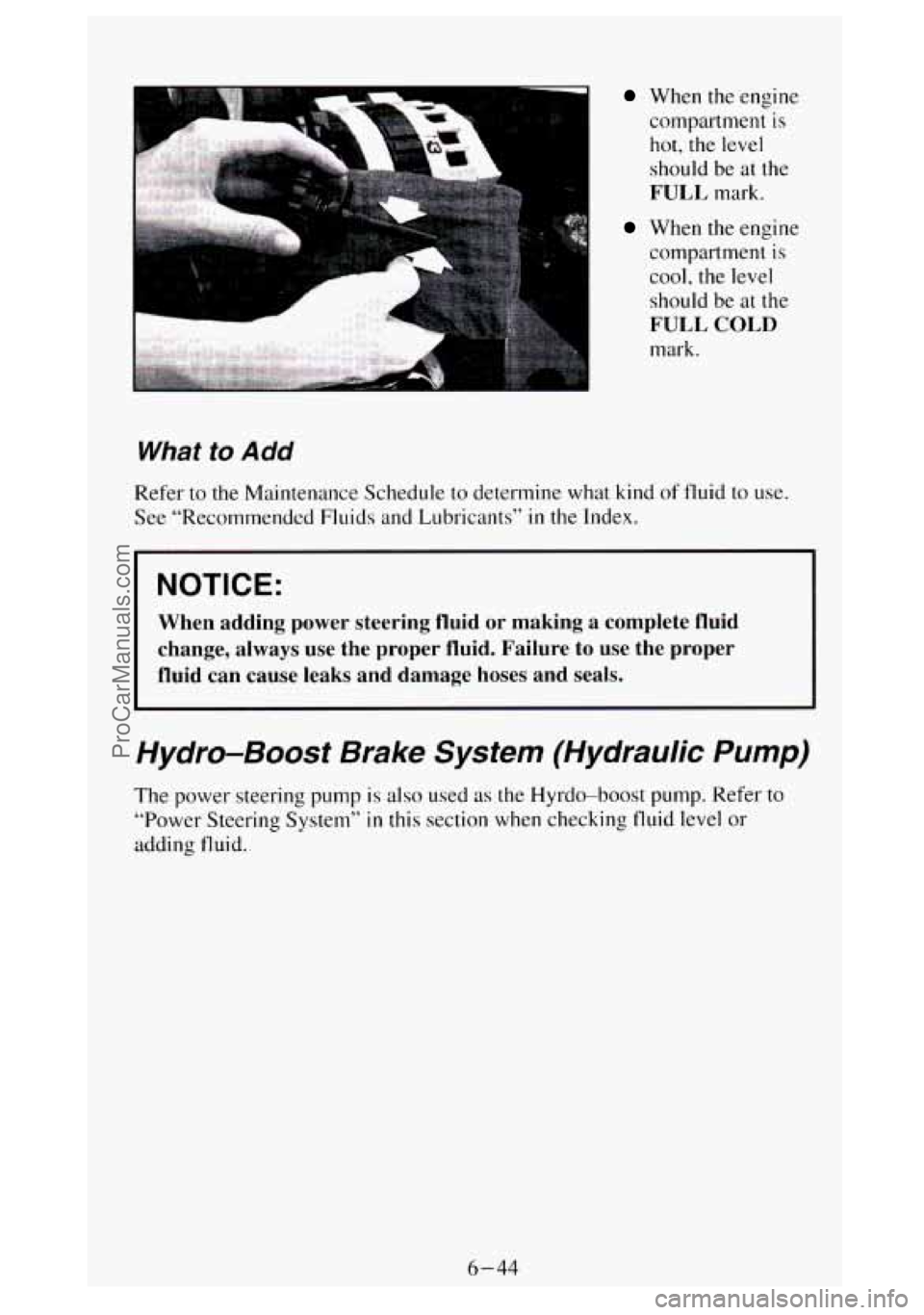
When the engine
compartment is
hot, the level
should be at the
FULL mark.
When the engine
compartment
is
cool, the level
should be at the
FULL COLD
mark.
What to Add
Refer to the Maintenance Schedule to determine what kind of fluid to use.
See “Recommended Fluids and Lubricants”
in the Index.
NOTICE:
When adding power steering fluid or making a complete fluid
change, always use the proper fluid. Failure
to use the proper
fluid can cause leaks and damage hoses and seals.
Hydro-Boost Brake System (Hydraulic Pump)
The power steering pump is also used as the Hyrdo-boost pump. Refer to
“Power Steering System”
in this section when checking fluid level or
adding tluid.
6-44
ProCarManuals.com
Page 295 of 404
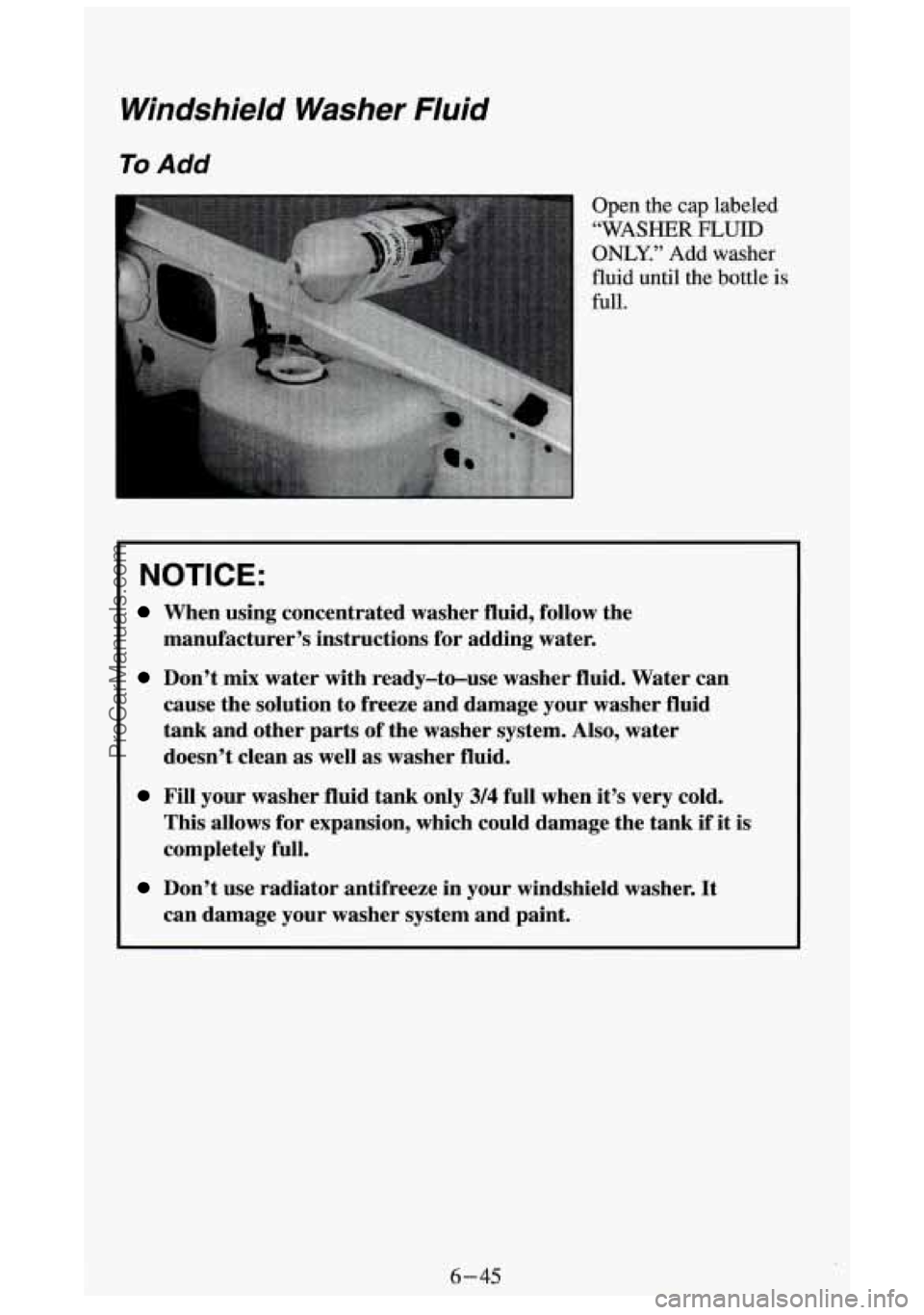
Windshield Washer Fluid
To Add
Open the cap labeled
“WASHER FLUID
ONLY.” Add washer
fluid until
the bottle is
full.
NOTICE:
When using concentrated washer fluid, follow the
manufacturer’s instructions for adding water.
Don’t mix water with ready-to-use washer fluid. Water can
cause the solution to freeze and damage your washer fluid
tank and other parts of the washer system. Also, water
doesn’t clean as well as washer fluid.
Fill your washer fluid tank only 314 full when it’s very cold.
This allows for expansion, which could damage the tank if it is
completely full.
Don’t use radiator antifreeze in your windshield washer. It
can damage your washer system and paint.
6-45
ProCarManuals.com
Page 296 of 404
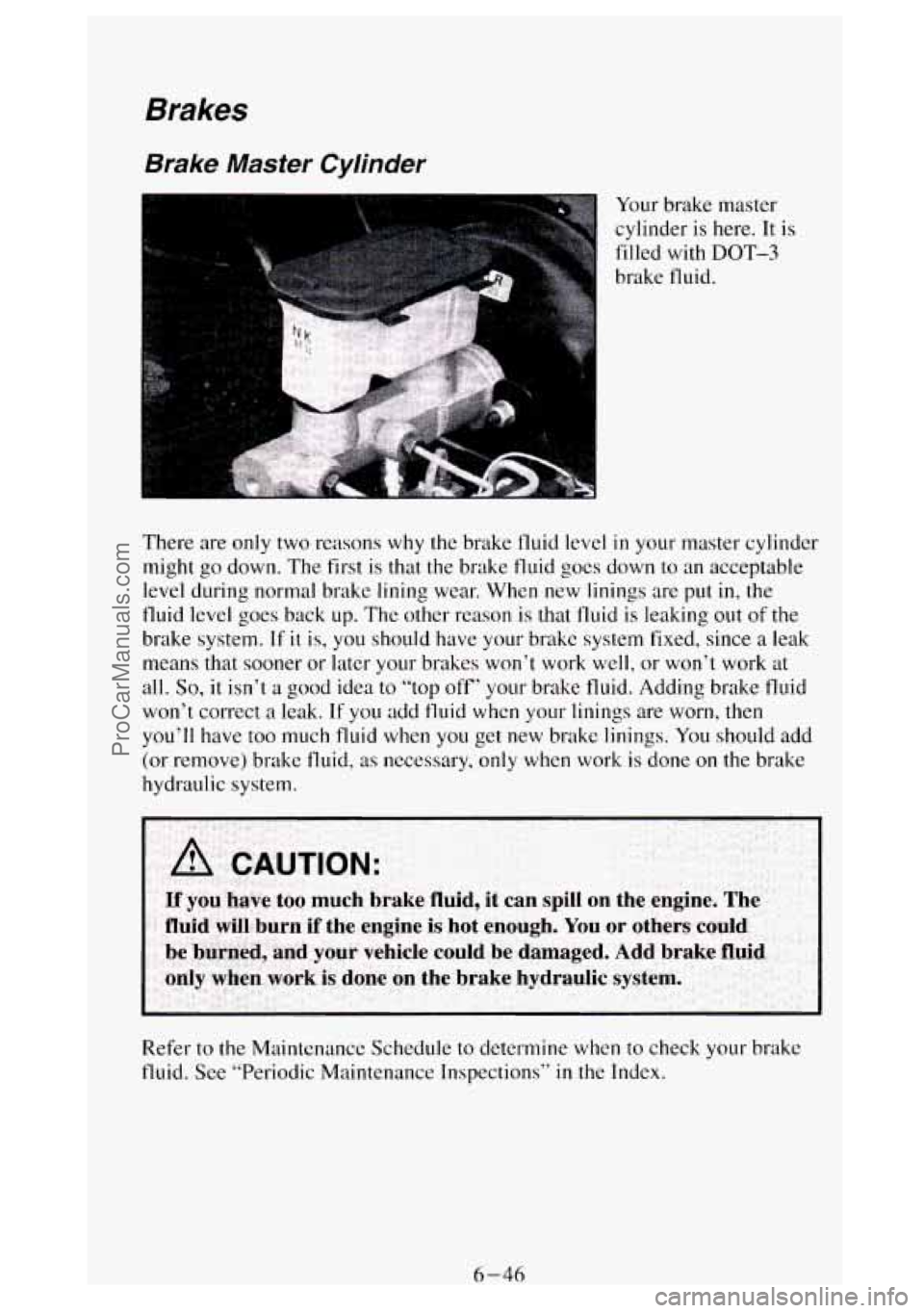
Brakes
Brake Master Cylinder
Your brake master
cylinder is here. It is
filled with
DOT-3
brake fluid.
There are only two reasons
why the brake fluid level in your master cylinder
might
go down, The first is that the brake fluid goes down to an acceptable
level during normal brake lining wear. When new linings are put in, the
fluid level goes back up. The other reason is that fluid is leaking
out of the
brake system.
If it is, you should have your brake system fixed, since a leak
means that sooner or later your brakes
won’t work well, or won’t work at
all.
So, it isn’t a good idea to “top off’ your brake fluid. Adding brake fluid
won’t correct a leak.
If you add fluid when your linings are worn, then
you’ll have
too much fluid when you get new brake linings. You should add
(or remove) brake fluid,
as necessary, only when work is done on the brake
hydraulic system.
Refer
to the Maintenance Schedule to determine when to check your brake
fluid. See “Periodic Maintenance Inspections”
in the Index.
6-46
ProCarManuals.com
Page 297 of 404
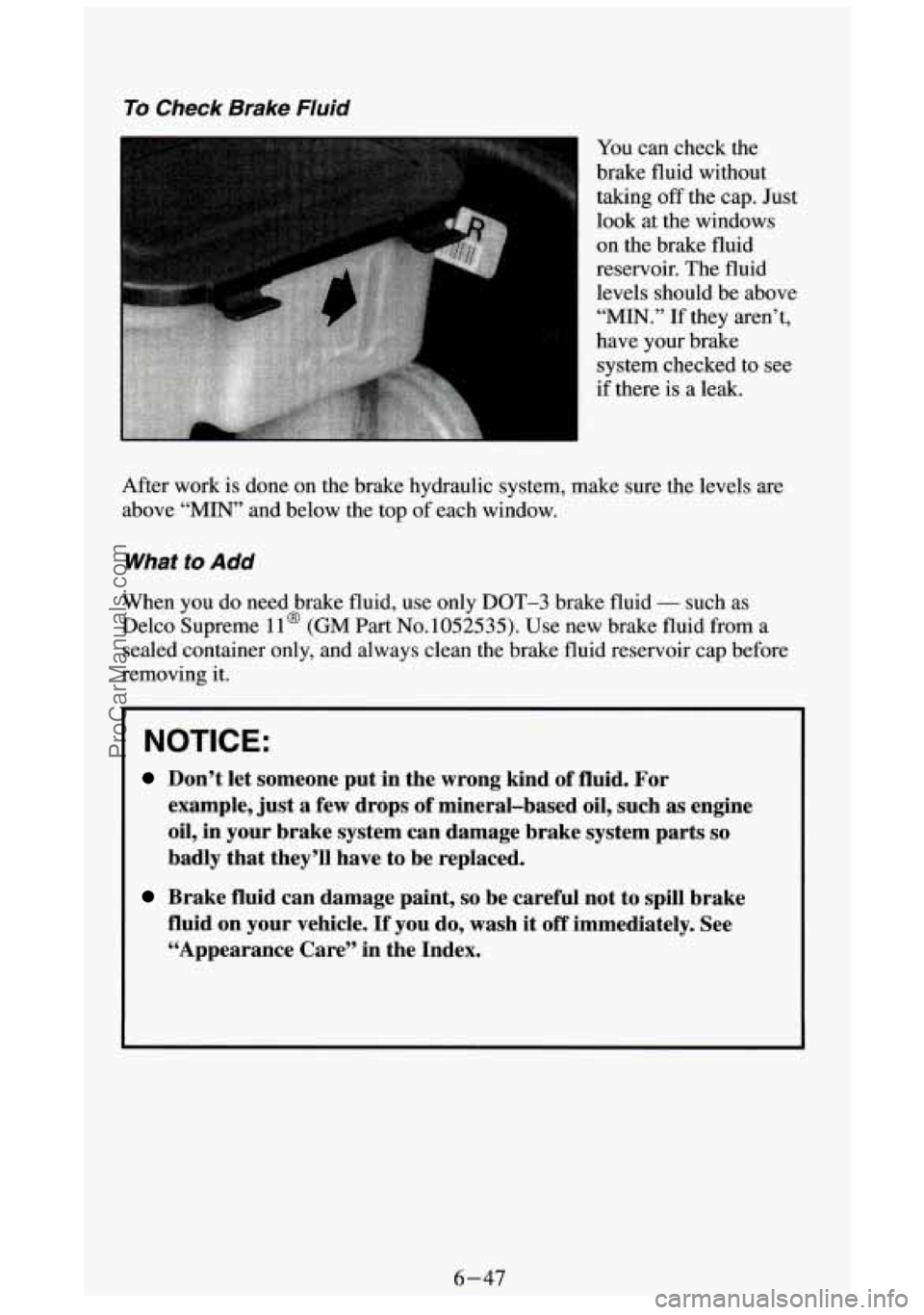
To Check Brake Fluid
You can check the
brake fluid without
taking off the cap. Just
look at the windows
on the brake fluid
reservoir. The fluid
levels should be above
“MIN.” If they aren’t,
have your brake system checked to see
if there is a leak.
After work
is done on the brake hydraulic system, make sure the levels are
above
“MIN” and below the top of each window.
What to Add
When you do need brake fluid, use only DOT-3 brake fluid - such as
Delco Supreme
ll@ (GM Part No.1052535). Use new brake fluid from a
sealed container only, and always clean the brake fluid reservo\
ir cap before
removing it.
NOTICE:
Don’t let someone put in the wrong kind of fluid. For
example, just
a few drops of mineral-based oil, such as engine
oil, in your brake system can damage brake system parts so
badly that they’ll have to be replaced.
Brake fluid can damage paint, so be careful not to spill brake
fluid
on your vehicle. If you do, wash it off immediately. See
“Appearance Care” in the Index.
6-47
ProCarManuals.com
Page 298 of 404
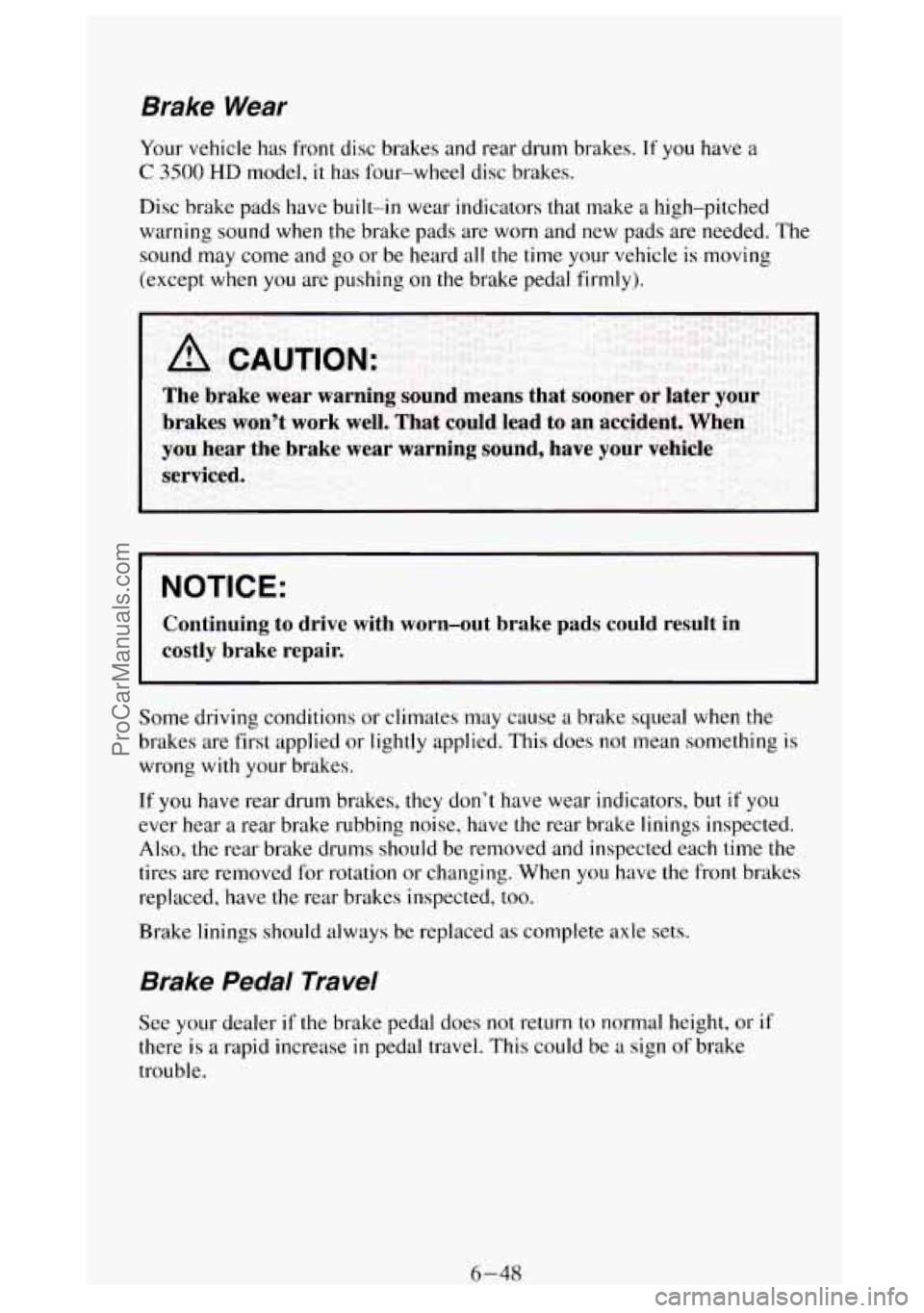
Brake Wear
Your vehicle has front disc brakes and rear drum brakes. If you have a
C 3500 HD model, it has four-wheel disc brakes.
Disc brake pads have built-in wear indicators that make
a high-pitched
warning sound when the brake pads are worn and new pads are needed. The
sound may come and go or be heard
all the time your vehicle is moving
(except when you are pushing on the brake pedal firmly).
The brake wear warning sound means that sooner or later your
brakes won’t work well. That could lead to an accident.
When
you hear the brake wear warning sound, have your vehicle
serviced.
NOTICE:
Continuing to drive with worn-out brake pads could result in
costly brake repair.
Some driving conditions or climates may cause a brake squeal when the
brakes are first applied or lightly applied. This does not mean something is
wrong with your brakes.
If
you have rear drum brakes, they don’t have wear indicators, but if you
ever hear a rear brake rubbing noise, have
the rear brake linings inspected.
Also, the rear brake drums should be removed and inspected each time the
tires are removed for rotation or changing. When you have
the front brakes
replaced, have the rear brakes inspected, too.
Brake linings should always be replaced
as complete axle sets.
Brake Pedal Travel
See your dealer if the brake pedal does not return to normal height, or if
there is a rapid increase in pedal travel. This could be a sign of brake
trouble.
6-48
ProCarManuals.com
Page 299 of 404
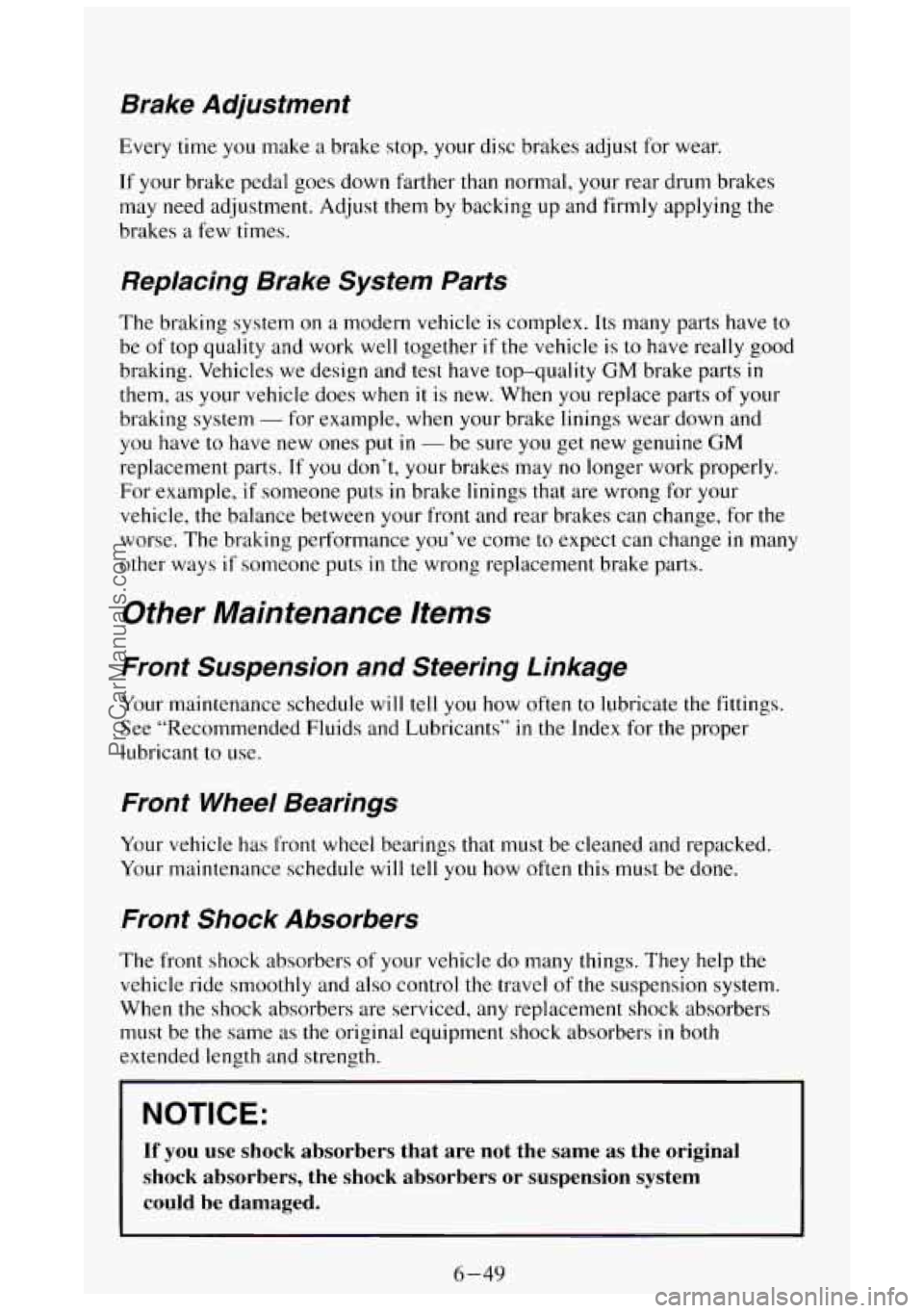
Brake Adjustment
Every time you make a brake stop, your disc brakes adjust for wear.
If your brake pedal goes down farther than normal, your rear drum brakes
may need adjustment. Adjust them by backing up and firmly applying
the
brakes a few times.
Replacing Brake System Parts
The braking system on a modern vehicle is complex. Its many parts have to
be of top quality and work well together if the vehicle is to have really good
braking. Vehicles we design and test have top-quality
GM brake parts in
them, as your vehicle does when it is new. When you replace parts of your
braking system
- for example, when your brake linings wear down and
you have to have new ones put
in - be sure you get new genuine GM
replacement parts. If you don’t, your brakes may no longer work properly.
For example,
if someone puts in brake linings that are wrong for your
vehicle, the balance between your front and rear brakes can change, for
the
worse. The braking performance you’ve come to expect can change in many
other ways if someone puts in the wrong replacement brake parts.
Other Maintenance Hems
Front Suspension and Steering Linkage
Your maintenance schedule will tell you how often to lubricate the fittings.
See “Recommended Fluids and Lubricants”
in the Index for the proper
lubricant to use.
Front Wheel Bearings
Your vehicle has front wheel bearings that must be cleaned and repacked.
Your maintenance schedule
will tell you how often this must be done.
Front Shock Absorbers
The front shock absorbers of your vehicle do many things. They help the
vehicle ride smoothly and also control
the travel of the suspension system.
When the shock absorbers are serviced, any replacement shock absorbers
must be
the same as the original equipment shock absorbers in both
extended length and strength.
NOTICE:
If you use shock absorbers that are not the same as the original
shock absorbers, the shock absorbers
or suspension system
could be damaged.
6-49
ProCarManuals.com
Page 300 of 404
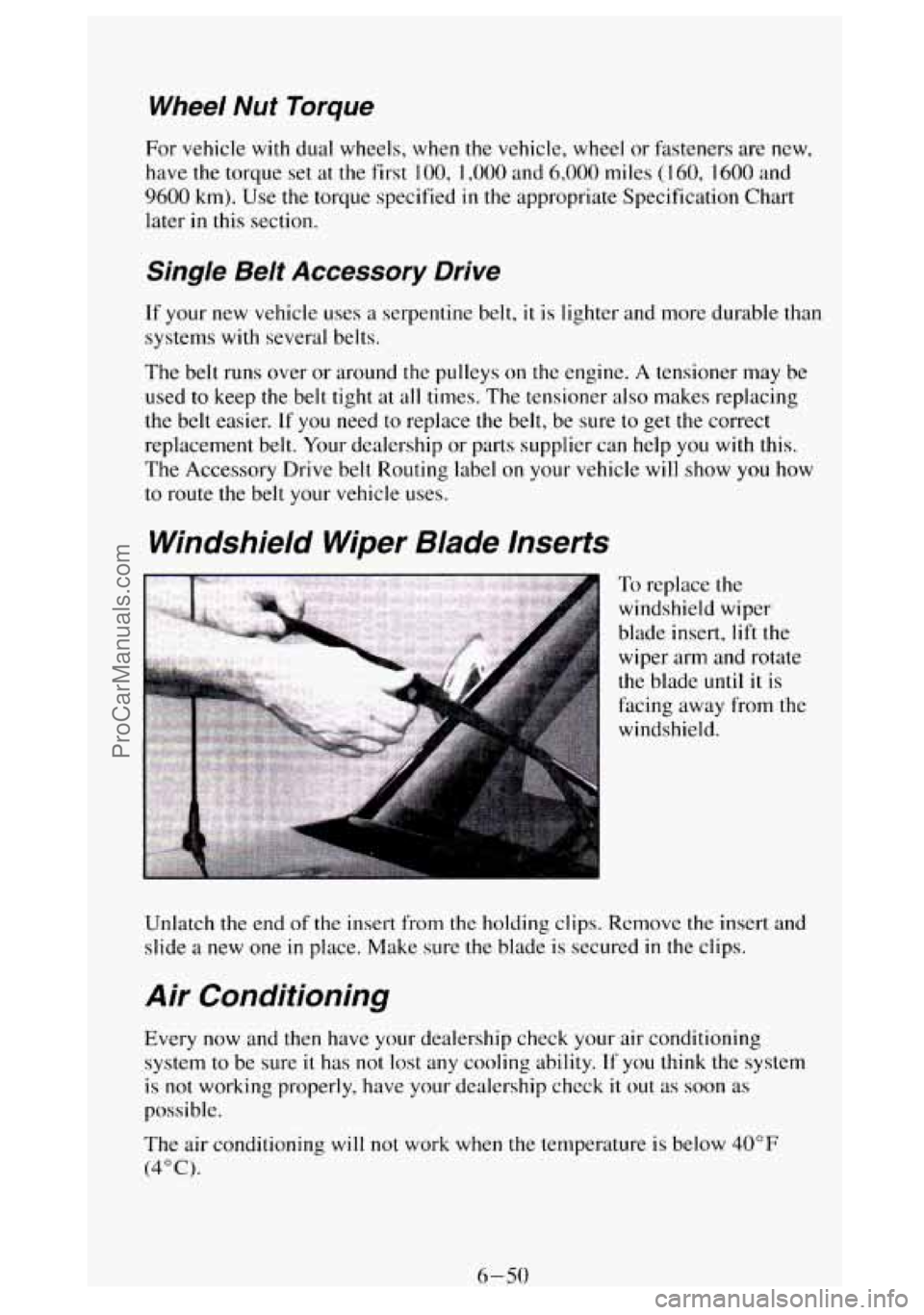
Wheel Nut Torque
For vehicle with dual wheels, wnen the vehicle, wheel or Tasteners are new,
have the torque set at
the first 100, 1,000 and 6,000 miles (1 60, 1600 and
9600 km). Use the torque specified
in the appropriate Specification Chart
later
in this section.
Single Belt Accessory Drive
If your new vehicle uses a serpentine belt, it is lighter and more durable than
systems with several belts.
The belt runs over or around the pulleys on the engine.
A tensioner may be
used
to keep the belt tight at all times. The tensioner also makes replacing
the belt easier.
If you need to replace the belt, be sure to get the correct
replacement belt. Your dealership or parts supplier can help you with this.
The Accessory Drive belt Routing label on your vehicle will show
you how
to route
the belt your vehicle uses.
Windshield Wiper Blade Inserts
To replace the
windshield wiper
blade insert, lift the
wiper arm and rotate
the blade until
it is
facing away from the
windshield.
Unlatch
the end of the insert from the holding clips. Remove the insert and
slide a new
one in place. Make sure the blade is secured in the clips.
Air Conditioning
Every now and then have your dealership check your air conditioning
system
to be sure it has not lost any cooling ability. If you think the system
is not working properly, have your dealership check it out as soon as
possible.
The air conditioning
will not work when the temperature is below 40°F
(4°C).
6-50
ProCarManuals.com